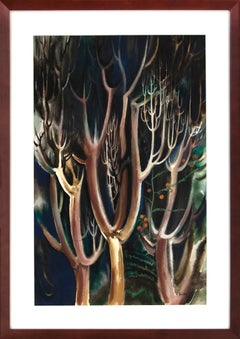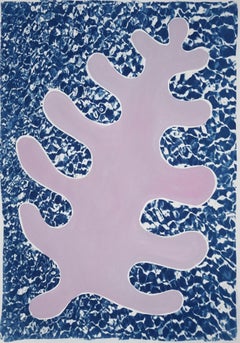Richard Sorby Art
J. Richard Sorby earned his bachelor of fine arts degree at the Colorado State College of Education (now the University of Northern Colorado) in Greeley, where he studied with Estelle Stinchfield, a founder member of the Denver Artists Guild in 1928. Following graduation, he was an art instructor for four years at Greeley High School before joining the faculty at the University of Nebraska in Lincoln (1941–42). He also studied privately with Vance Kirkland and William Joseph Eastman of Cleveland, Ohio, who was active in Colorado. Beginning in the early 1940s, Sorby employed a modernistic style for the representational subject matter he painted throughout his career, as seen in his watercolor of a Colorado subject, Hogback Range and Cherry Trees (c. 1941), now in the collection of the Smithsonian American Art Museum. The painting was included in an exhibition of 200 American watercolors at the National Gallery of Art in Washington D.C. in 1941. During the Second World War, Sorby was a Lieutenant in the U.S. Naval Reserves. After naval training in Arizona, Ohio, Oklahoma and Florida, he served as a recognition and training officer at the Naval Flight Prep School for aviation cadets in Monmouth, Illinois. He later was assigned to Trinidad in the British West Indies as a training officer for three squadrons of Martin Mariners (American patrol bomber flying boats designed in 1937). After the war, he rose to the rank of Lieutenant Commander in the Naval Reserve from which he retired in 1970.
In 1951, he earned his master’s degree at the Colorado State College in Greeley. His thesis provided an early indication of his later facility as an artist, because he did six oil paintings on the same subject, the harbor at Barbados, in six different styles, from realistic to non-objective. He also undertook postgraduate studies at the University of the Americas in Mexico City (1951), the University of California at Los Angeles with John Fetten (1953) and in the mid-1950s, at the University of Colorado-Boulder with Jimmy Ernst (son of pioneer artist of the Dada movement and Surrealism, Max Ernst) when he participated in the Visiting Artists Program there in the summers of 1954 and 1956. The influence of the younger Ernst’s work is reflected in Sorby’s watercolor, Spatial Tensions, "composed of fine light lines over dark free washes, creating the effect of light in space, such as celestial constellations." The painting is in the collection of the Nelson-Atkins Museum of Art in Kansas City, Missouri. While earning his master’s degree, Sorby started teaching in 1946 as an assistant professor in the art department at the University of Denver, later becoming an associate professor of painting and design, from which he retired in 1959. At the university, he was faculty advisor to the Daubers, a students’ club whose members enrolled in at least one art course and showed an interest in the profession. Students took sketching trips to hospitals around Denver and the nearby mountains and participated in the club’s annual Beaux Arts Ball. He also included his students' work in an illustrated slide lecture, "Design," presented at the general meeting of the Denver Artists Guild on November 13, 1957. He willingly shared his knowledge about art with students whom he met at visits to colleges outside Denver. It allowed them to encounter modern painting firsthand and to meet one of its creators who told them, "You must look at art with your heart and mind and head. If you do, it will make life more worthwhile… Artists are sensitive antennae of society. They must show life to interpret it."
Sorby used a variety of media, oil, watercolor, acrylic and pyroxylin to create representational and abstract interpretations inspired by nature. In the early 1950s the Ford Times, a widely-read travel and motoring magazine published by the Ford Motor Company in Detroit, commissioned him to paint an image of the Great Sand Dunes National Park in southern Colorado. His watercolor, Sand Dunes, illustrated a story, Incredible Sand Dunes by Marian Talmadge and Iris Gilmore in the May 1954 issue of the Lincoln-Mercury Times magazine. In an interview published in the October 1958 issue of The Club Bulletin in Denver, Sorby discussed his approach to painting: “Inspiration generally is derived from nature in one aspect or another. By nature, I mean much of the universe about us, the tangible world of land and water, and the intangible world of light, sky and air, the forces in nature of growth and life.” These themes have concerned artists since the Renaissance, although today it is more their essence than their outward form which the modern artist seeks to distill. In the early 1950s, Sorby began doing acrylics on masonite in a more modernistic, referentially-abstract style such as Sails and Whales (1951; Kirkland Museum of Fine & Decorative Art, Denver) and an urban-inspired scene, Spires and Wires, both dominated by geometric shapes. His painting, The Thorns (1955; Colorado Springs Fine Arts Center), creates the impression of a cruel and unapprehended post-war world. Other images are abstract, such as Fin Flash (1957) artfully capturing motion on a two-dimensional surface with a stylized, rotating vortex. A corrugated wood panel shown in the 1958 Metropolitan Exhibition at the Denver Art Museum, and perhaps inspired by the exhibition Le Mouvement at Galerie Denise René in Paris in 1955, Fin Flash conveys the optical illusions of Kinetic/Op Art. Evenly-spaced vertical lines and interlocking geometric shapes create a progression from warm to cool tones as the viewer moves in front of the composition. He painted the piece in pyroxylin, a durable but flammable medium similar to lacquer and polymer resin, which he encountered in Mexico in the early 1950s, where it had been successfully used for outdoor murals. As president of the 15 Colorado Artists, founded in Denver in 1948 to break away from the predominant academic and regionalist styles dominating the Denver Artists Guild, Sorby headed the artists’ protest in the local press in 1957 to Denver Art Museum director, Dr. Otto Karl Bach, about the lack of communication regarding the change made in the 63rd annual art exhibition from a juried to an invitational one and the inclusion of so few Colorado-based artists. John Lembach, editor of the Colorado State Art Association Bulletin, wrote of Sorby’s art in a joint exhibition held at Vance Kirkland’s Denver studio in the Fall of 1954 with John E. Billmyer and William Sanderson, fellow members of the 15 Colorado Artists: “[Sorby’s] paintings have that handsome quality characteristic of his Navy officer’s white uniform [a reference to his position in the Naval Reserve after World War II]... When looking at his paintings, we are always conscious of the importance of him, of the design element, his love of the precision of purism. His work is as streamlined as a sports car.” In his work, there is something of the beautiful design quality of Juan Gris modernized. In 1958, Sorby completed a painting, Papantla, for the Little Theater of the Rockies at the Colorado State College of Education, his alma mater, as a memorial to Denver artist, Elisabeth Spalding. The painting was inspired by Pre-Columbian art that fascinated him since his visit to Mexico in 1951. He also produced some limited edition lithographs of referentially-abstract landscape vignettes. He relocated to California in 1959, where for the next 13 years, he was professor of design and painting at the California State University, San Jose, becoming professor emeritus in 1972. He also was a guest professor at the Southern Utah University, Cedar City in June and July 1964. He served as vice president of the East Bay Art Association (1966–68) and president of Group 21 in Los Gatos, California (1970–71). An example of his work from the 1960s is Bridge, a California-inspired composition of an abstracted bridge image whose structure is defined with geometric shapes of varying sizes and animated by the light effects and the progression through several layers of superimposed planes to a cityscape backdrop. In retirement, he designed and built a home in the Paso Robles area before settling in Sun City with his wife, Elizabeth, a former art teacher whom he married in 1950. Following her death, he spent the remainder of his life as Artist-in-Residence at Casa de las Campanas, a retirement community in Rancho Bernardo in the northern hills of San Diego, California. During his affiliation with the University of Denver, he had two one-man shows at the Denver Art Museum (1948, 1954) and participated in a number of its annual exhibitions. He also showed at important national venues outside the state such as the Whitney Museum of American Art, New York; the National Gallery of Art, Washington D.C.; the Pennsylvania Academy of the Fine Arts, Philadelphia; the Cleveland Museum of Art; the Detroit Institute of Art, Walker Art Center, Minneapolis; the Art Institute of Chicago; the Nelson-Atkins Museum of Art, Kansas City, Missouri; the Joslyn Art Museum, Omaha; the Crocker Art Gallery, Sacramento and the San Diego Art Institute.
20th Century Abstract Richard Sorby Art
Oil
1940s American Modern Richard Sorby Art
Watercolor, Archival Paper
2010s Abstract Richard Sorby Art
Archival Ink, Mixed Media, Oil, Acrylic, Watercolor, Archival Paper
Mid-20th Century American Modern Richard Sorby Art
Paper, Crayon
1920s American Modern Richard Sorby Art
Watercolor
2010s Contemporary Richard Sorby Art
Watercolor, Archival Paper
2010s Abstract Richard Sorby Art
Oil
2010s Abstract Richard Sorby Art
Wax, Encaustic, Oil
1930s American Modern Richard Sorby Art
Paper, Pastel
1930s American Modern Richard Sorby Art
Board, Gouache
1930s American Modern Richard Sorby Art
Watercolor, Gouache
1940s American Modern Richard Sorby Art
Paper, Watercolor
1920s American Modern Richard Sorby Art
Watercolor
1930s American Modern Richard Sorby Art
Paper, Pastel
Mid-20th Century Abstract Expressionist Richard Sorby Art
Mixed Media
Mid-20th Century Abstract Expressionist Richard Sorby Art
Masonite, Oil





